2016
OFFENDER POPULATION JUNE 30, 2016
INMATES: 99,119
SUPERVISED: 136,956
INMATES: 99,119
SUPERVISED: 136,956
FORMER SECRETARY EDWIN G. BUSS DIES
Former Secretary Edwin G. Buss dies unexpectedly at his home in La Porte, Indiana at the age of 50 on January 15, 2016. Appointed by Governor Rick Scott, he had been Secretary for the Department for only eight months in 2011. One legacy of his short tenure was the banning of cigarettes in Florida prisons. https://www.lakeviewfhc.com/obituaries/Edwin-G-Buss?obId=724775
At the direction of Secretary Jones, FDC updates its vision, mission, values and goals as part of the year’s new modernization and improvement process. These changes better characterize its focus on data driven strategies that produce compassionate and rehabilitative outcomes. New vision: “Inspiring success by transforming one life at a time.” New mission: “Provide a continuum of services to meet the needs of those entrusted to our care, creating a safe and professional environment with the outcome of reduced victimization, safer communities and an emphasis on the premium of life.” New values: Safety, Accountability, Fairness & Integrity and Innovation New goals: Talent Development, Inmate/Offender Programs, Communications and Environment.
Along with a change in vision, mission, values and goals, there is also a change in uniforms and logos/seals for the first time in decades. The previous uniform of dark brown pants with either a tan shirt for Correctional Officers and Sergeants, and a white shirt for Lieutenants, Captains, Majors or Colonels (left) is replaced with the crisper, more modern uniforms seen today.

Old Uniforms

New Uniforms

New Uniform
The new seal reflects the Department’s change in abbreviation from DC to FDC, and its more updated color palette.

The Department reorganizes its structure from three to four regions, which reduces the number of institutions each director supervises, allowing regional directors more time to monitor and oversee all facilities.
JANUARY 26, 2016
A four-count complaint for declaratory and injunctive relief is filed by Disability Rights Florida, Inc., alleging that the FDC is violating the laws protecting people with disabilities who are incarcerated in the Florida prison system.
RIOT AT FRANKLIN C.I.
Inmates at Franklin Correctional Institution rioted in two prison dormitories on June 9, 2016 rendering them uninhabitable. Approximately 300 inmates participated in the riot, using makeshift tools and weapons to drill through a concrete and brick wall, destroying bathrooms, telephones, ceiling fans and housing areas. Prison Rapid Response Teams brought the inmates under control, and there were no serious injuries. The inmates involved were moved to other institutions, and the prison was placed on lockdown, which is standard procedure. The riot was blamed, in part, on understaffing, which led to inmates having less recreation time because there isn’t enough staff to supervise them. In addition, state prison dorms are not air-conditioned, and the heat tends to exacerbate tensions. Prisons continue to operate at critical staffing levels.
RIOT AT HOLMES C.I.
On September 7, 2016 another riot breaks out, this time at Holmes CI in the Panhandle. More than 400 inmates riot to protest prison conditions, damaging every dorm on the compound (see pictures below) and lasting into the early morning. No serious injuries were reported. It lasted for approximately ten hours during which inmates smashed cameras and other fixtures, ransacked the dorms, tore away the ceiling and hid in crawlspaces. Prison Rapid Response Teams were called in to quell the disturbance, as were numerous officers from nearby institutions.
Upon review of these riots and other disturbances, significant changes in the way disturbances are handled are implemented.
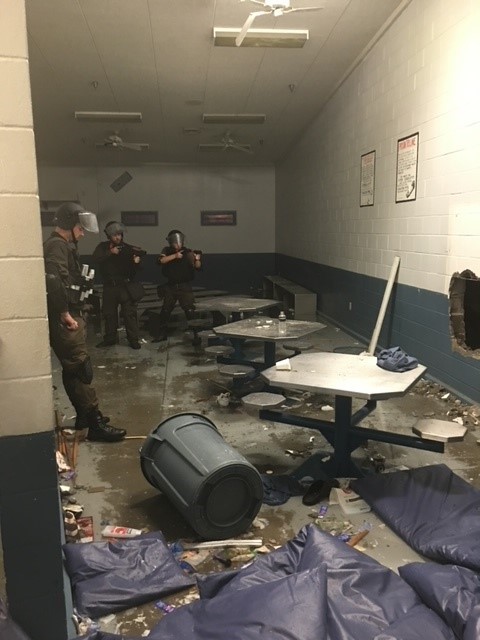
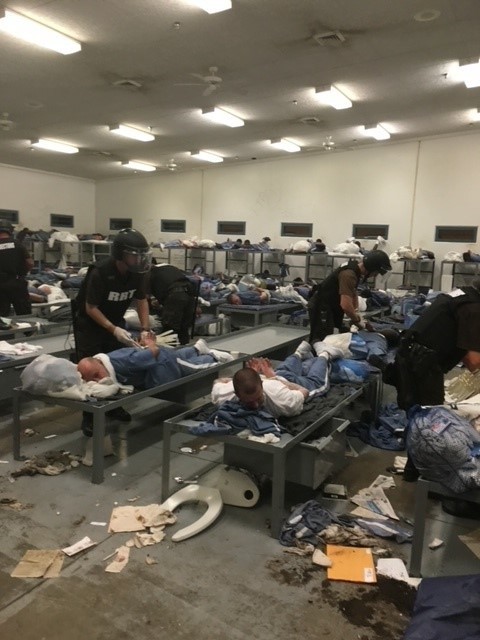
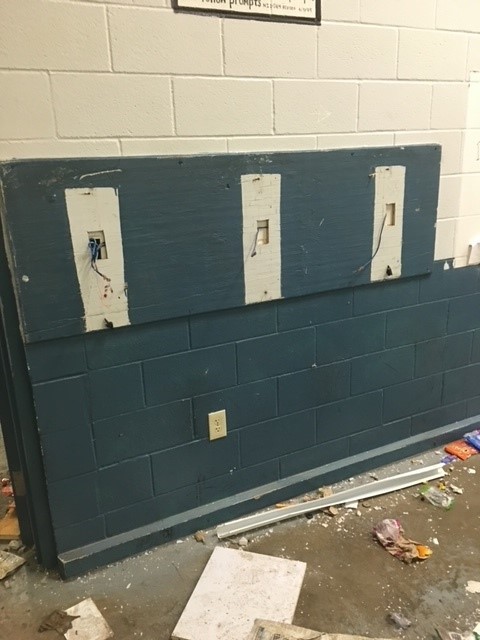
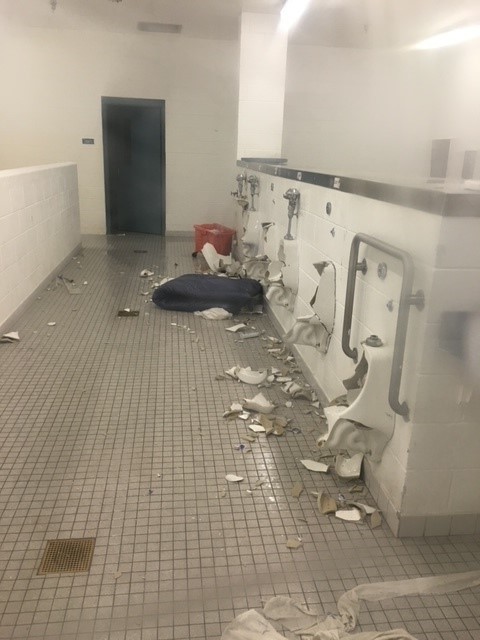
Florida statutorily abolishes judicial override, the process by which trial judges are allowed to impose death sentences even when juries recommend life sentences.
There are a total of 19,956 active volunteers working with the FDC.
BIOMETRIC VOICE DETECTION
FDC upgrades the inmate telephone system with biometric voice detection. This ensures the inmate population is only able to use their assigned pin number to make telephone calls to people on their approved phone list, which helps eliminate intimidation and other nefarious activities by inmates via telephone. Additionally, funding is acquired to ensure each main unit, annex and work camp is able to acquire a magneto static detection unit. These devices detect illegal cell phones in the possession of inmates. FDC also opened a cellphone forensic lab, which becomes fully operational in April 2016 under FDC’s Office of Intelligence.
DOG PROGRAMS
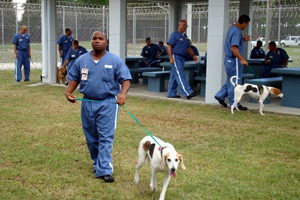
Since the first dog program was implemented in 2007, the FDC now has 21 Dog Obedience Programs throughout Florida. These programs pair inmates with dogs from local shelters to prepare dogs for adoption or to become service animals. Since its inception, the programs have graduated more than 3,696 dogs who were adopted to forever homes, and more than 3,350 inmates have been involved as caretakers, handlers, and trainers.

Every dog pictured above was adopted through our inmate dog programs.
The Department operates farm programs at 39 parent institution farms and six University of Florida Institute of Food and Agricultural Sciences facilities, producing more than seven million pounds of fresh produce this year.
The FDC’s canine tracking teams are deployed 805 times; 317 times for criminal incidents, with 227 of those involving armed individuals. Missing person searches accounted for 261 deployments.
More than 12,000 state identification cards and over 9,000 replacement social security cards are issued to inmates nearing release through partnerships with the Department of Highway Safety and Motor Vehicles and the Social Security Administration.
The recidivism rate for inmates rises to 25.4% (for inmates who were released in 2013), meaning for those inmates who were released in 2013, 25.4% of them returned to a Florida state prison within a three-year period.
Only one inmate is executed in 2016: Oscar Ray Bolin, Jr. He has been in prison or jail since October 30, 1992 on a murder charge or conviction, but due to his sentence being vacated and a retrial, not all of that time is spent on death row.
2017
OFFENDER POPULATION JUNE 30, 2017
INMATES: 97,794
SUPERVISED: 167,230
INMATES: 97,794
SUPERVISED: 167,230
Beginning in 2017 all four types of supervision are now being reported in annual population totals. In 1993, we started including offenders in Active-Suspense (those temporarily unavailable for direct supervision, i.e., in jail, federal custody, ICE detainer) status. Before that, we only counted the Active offenders. This year we also start including all Out-of-State (Florida offenders transferred to another state that are monitored by a Florida officer for compliance) and Absconders (offenders with a warrant issued due to whereabouts unknown) in our annual totals. We continue to include all four types today.
 FDC launches an enhanced recruitment campaign, promoting a “Career of Service” and designed to attract and recruit new correctional officers. It deploys several creative media formats including a video, movie theater ads, billboards, gas pump toppers and radio advertisements.
FDC launches an enhanced recruitment campaign, promoting a “Career of Service” and designed to attract and recruit new correctional officers. It deploys several creative media formats including a video, movie theater ads, billboards, gas pump toppers and radio advertisements.
A three-tier recruitment and retention plan for FDC is passed by Governor Rick Scott and the legislature during the legislative session. The plan provides an increase in the base pay for correctional officers, a ten percent increase in pay for officers who work in inpatient mental health housing units and a hiring bonus for new officers at facilities with high vacancy rates.
HEALTHCARE - HEPATITIS C LAWSUIT
On May 11, inmates file a three-count class action lawsuit alleging that FDC is not giving inmates with Hepatitis C (HCV) the treatment they need. In December 2017, the court issues a preliminary injunction in this matter that is subsequently modified. The injunction requires the Department to initiate treatment for all known chronic HCV inmates who are eligible for treatment who have fibrosis stages 2 and 3. The Department is also required to evaluate and stage inmates who have chronic HCV. In addition, the department is required to ensure that FDC staff and contractors comply with the HCV treatment policy as it is revised.
House Bill 7091 is signed into law updating Florida Statute Chapter 948 to more effectively and efficiently supervise those on supervision. The most significant change clarified that a warrant tolling (pausing) probation supervision may be issued for a violation of the terms and conditions of supervision, and thus, that a crime need not be committed for tolling to occur.
GAINTIME FOR GEDS OR VOCATIONAL CERTIFICATES
First District Court of Appeals (DCA) issues an opinion in Newell vs. FDC and determines that the FDC has the statutory authority to award, within its discretion, 60 days of gaintime to inmates whose crimes were committed on or after October 1, 1995, and who have completed their G.E.D. certificates, and who are awarded a G.E.D. or vocational certificate.
The Miami-Dade Portal, a grant-funded pilot through the Second Chance federal grant, began October 1, 2016, and serves pre-release inmates at Everglades Re-Entry Center and post-released inmates who are releasing to Miami-Dade County from any Florida institution. Services include risk/needs assessment, mental health services, substance use treatment services, housing, education/vocational services, employability skills and services to ensure inmates are employed. By June 30, 2017, over 200 pre-release inmates have been served and approximately 60 post-release. Similar portals have been created for Broward and Palm Beach Counties.
PRISON RIOTS AT GULF C.I.
 In July 2017, approximately 20 inmates at Gulf CI take over several dorms and injure seven correctional officers.
In July 2017, approximately 20 inmates at Gulf CI take over several dorms and injure seven correctional officers.
Tallahassee Democrat (Tallahassee, Florida) · 22 Jun 2017, Thu · Page A2.
Also in July, the FDC enters into a settlement agreement with Disability Rights Florida, Inc., to address the needs of inmates with mobility and vision disabilities, as well as those who are deaf/hard of hearing.
The Home Builders Institute (HBI) program provides certification, pre-apprenticeship and job placement services to offenders on supervision in Circuits 11,17,15 and 9, resulting in certification for approximately 196 individuals.
New River Correctional Institution reopens and is staffed to serve as specialty housing for inmates transitioning from close management to general population.
 Hurricane Irma, a Category 4 hurricane, makes landfall at Cudjoe Key on September 10. Irma, which is downgraded from a Category 5 hurricane shortly before landfall, led to the largest evacuation of inmates in Florida corrections history. FDC successfully evacuates more than 12,000 inmates in the storm's path.
Hurricane Irma, a Category 4 hurricane, makes landfall at Cudjoe Key on September 10. Irma, which is downgraded from a Category 5 hurricane shortly before landfall, led to the largest evacuation of inmates in Florida corrections history. FDC successfully evacuates more than 12,000 inmates in the storm's path.
Florida statutorily abolishes non-unanimous jury recommendations for death and requires that the sentencing jury unanimously recommend a death sentence before the trial judge can impose a death sentence.
The Department partners with Florida Gateway College to provide 65 inmates at Columbia Correctional Institution Annex with the opportunity to earn an associate’s degree through live and online instruction. The Second Chance Pell pilot is authorized by the United States Department of Education.
Community Corrections launches the Merit-Based Activity (MBA) program, which provides incentives to offenders on Community Control, the most restrictive level of supervision. If they successfully complete a rehabilitation program, these offenders are allowed to attend pre-approved activities, at the discretion of their supervising officer.
Seventeen facilities received ACA reaccreditation. All facilities presented for accreditation during this fiscal year achieved 100 percent on mandatory standards and averaged 98.3 percent on non-mandatory standards.
K-9 tracking teams are deployed 1,550 times for criminal incidents and missing person searches. Deployment of K-9 teams inside the institutions is increased to better combat contraband. Efforts are made to revise the Department’s search policy and deployment schedule to ensure K-9 teams operate seven days a week to monitor inmate visitation activities.
The recidivism rate for inmates drops to 24.5% (for inmates who were released in 2014), meaning for those inmates who were released in 2014, 24.5% of them returned to a Florida state prison within a three-year period.
There are three executions in 2017. They are:
- Mark Asay (almost 29 years on death row);
- Michael Lambrix (33.5 years on death row); and
- Patrick Hannon (26 years on death row).
- 1821-1845
- 1868-1876
- 1877-1895
- 1900-1919
- 1921
- 1922-1924
- 1927
- 1928-1931
- 1932 | CHAPMAN
- 1933-1935
- 1936-1939
- 1940-1945
- 1946-1949
- 1950-1955
- 1956-1961
- 1962 | WAINWRIGHT
- 1963-1965
- 1966-1969
- 1970-1975
- 1976-1979
- 1980-1986
- 1987 | DUGGER
- 1988-1990
- 1991 | SINGLETARY
- 1992-1995
- 1996-1998
- 1999 | MOORE
- 2000-2002
- 2003 | CROSBY
- 2004-2005
- 2006 | MCDONOUGH
- 2007
- 2008 | MCNEIL
- 2009-2010
- 2011 | BUSS
- 2011 | TUCKER
- 2012 | CREWS
- 2013-2014
- 2014 | JONES
- 2015-2018
- 2019 | INCH
- 2020-2021
- 2021 | DIXON
- 2022-Today
- Population Summary Table

